Rental property maintenance minimizes the risk of costly damages resulting from neglect, abuse, or normal wear and tear. Landlords use a rental property maintenance checklist to guide them during routine, seasonal, and preventative maintenance. This checklist helps them schedule tasks, outsource certain tasks to vendors, and ensure nothing is forgotten during the maintenance process. In conjunction with the lease agreement, this differentiates the maintenance responsibilities of a landlord and a tenant.
Download our free property maintenance checklist to ensure you have all the items you need to prepare. The checklist is organized by time frame so you can plan a landlord maintenance schedule across the year.
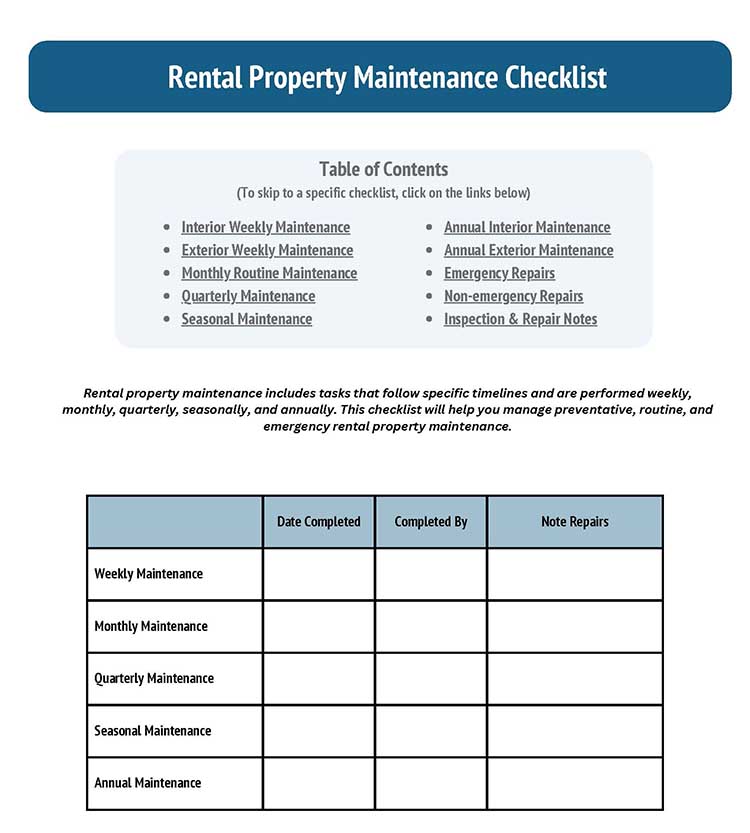
Thank you for downloading!
Quick tip: Embrace the power of modern financial technology with Baselane. Tailored for independent landlords, Baselane is a groundbreaking financial operating system and banking platform that simplifies the way you manage your rentals. No more manual processes or fragmented solutions; get started with Baselane today and unlock automated tools, actionable data, and dedicated financial services designed just for you.
Items to Include on Your Rental Property Maintenance Checklist
It is the landlord’s duty to meet the health and safety standards mandated by the state. By performing routine maintenance, landlords decrease the risk of developing costly damages and performing emergency repairs on their rental property. To keep your rentals in great shape, you’ll need to perform various weekly, monthly, quarterly, seasonal, annual, and unexpected maintenance tasks.
Weekly Maintenance
Weekly maintenance tasks in your property management checklist include managing the immediate interior and exterior areas of the property. This includes removing trash, cleaning common areas, such as entryways, hallways, laundry rooms, and stairwells, as well as maintaining the lawn and garden. Depending on the season, you may need to rake leaves, mow the lawn, remove fallen branches and other debris, or shovel snow. Don’t forget to weed flower beds and water plants as necessary.
Check out the table below to see the interior and exterior tasks that should be on your weekly property management preventive maintenance checklist, as well as the supplies you need to stock up on if you intend to do the maintenance yourself.
Interior Weekly Maintenance | Exterior Weekly Maintenance |
|---|---|
|
|
Supplies Needed | |
|
|
Monthly Routine Maintenance
If the property is cleaned every week, it’s easier to conduct monthly routine maintenance. Monthly maintenance focuses more on performing inspections and addressing unresolved maintenance issues. Though there may be less work to do, performing monthly general inspections helps property managers identify issues that might otherwise have missed during weekly maintenance.
To be more efficient, conduct monthly inspections and repairs on the same day you do weekly maintenance. Below are examples of property maintenance tasks that should be done monthly:
- Inspect common area lighting and replace burnt-out bulbs
- Inspect basement and attic to make sure attic vents and sump pumps are in working condition
- Make sure window and door locks are functional; repair broken glass or torn screens
- Check for damage in common areas and that nothing is blocking entrances
- Check bait and traps used for pest control, replenish bait, remove dead rodents or bugs
- Check and clean gutters and make sure outdoor lighting is functional
- Inspect walkways, walls, paving, and driveways for safety; repair or clean as needed
Quarterly or Seasonal Maintenance
Seasonal preventative maintenance is crucial for preserving your rental property and ensuring tenant satisfaction as seasons and weather change. Your specific seasonal maintenance tasks will depend on your property’s location and climate, but there are certain chores that you will need to perform quarterly, regardless of the changing seasons.
Overall, seasonal and quarterly maintenance tasks include the following:
- Clean air filters in HVAC ducts
- Ventilate the common areas
- Check screens and storm windows; repair/replace as needed
- Swap storm windows and doors for screens, or vice versa
- Check heating and cooling thermostats
- Inspect for frozen exterior faucets, ice dams, and repair as needed
- Winterize or re-open seasonal rentals and vacant units
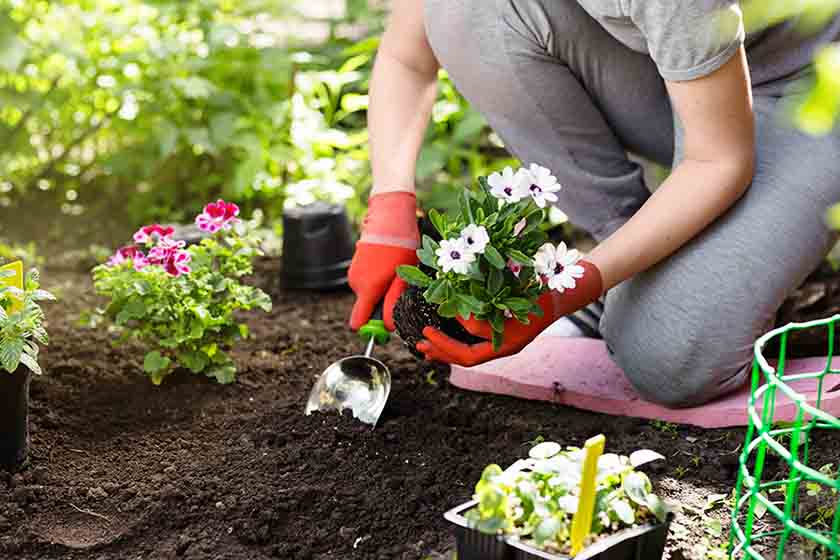
Season | Maintenance to Perform |
|---|---|
Spring & Summer | Warmer weather facilitates regular maintenance and general property upkeep. It is also ideal for enhancing curb appeal with landscaping projects. Moreover, HVAC (heat, ventilation, and air conditioning) system issues may be caused by heat and humidity, so perform HVAC preventive maintenance property management at the start of the season. |
Fall | In some states, fall offers moderate temperatures and dry weather, making it ideal for maintenance. Prevent costly repairs by clearing leaves and debris from gutters and downspouts. Make sure to mend cracks and gaps in windows and doors, inspect roofing and fireplaces, and tune up major appliances before the holidays. |
Winter | Winter poses risks like frozen pipes and damaged roofs due to below-freezing temperatures. Snowstorms can also lead to tree breakage, posing safety concerns. Ensure to conduct a thorough property inspection at the end of fall before the onset of colder weather. |
To ensure minimal disruption to your tenants, schedule inspection appointments and communicate clearly about maintenance work, its schedule, and the responsible party. Furthermore, use a landlord maintenance checklist to ensure your property remains in top condition, covering everything from the basement to the roof.
Annual Maintenance
Some maintenance tasks only need to be performed once per year, but they don’t have to be addressed at the same time. These tasks are often big projects, so you can schedule them throughout the year for greater efficiency. Like monthly maintenance, many annual tasks involve inspections when tenants move at the end of a lease. This will help you identify tenant-caused damages and perform repairs when necessary.
Yearly maintenance also requires you to check the rental property’s interior and exterior. Check out the table below to see which tasks should be included in your property manager checklist for annual inspection.
Interior Maintenance | Exterior Maintenance |
|---|---|
|
|
With regular rental property maintenance, many of the tasks won’t take much time or money. Deferred maintenance can be problematic as damages may worsen and become expensive repairs over time. Furthermore, well-maintained rental properties command higher rents and sell for higher prices, so it is worth it to keep on top of your routine maintenance.
Emergency & Non-emergency Repairs
Despite performing regular maintenance, you may still encounter unexpected damages. Unexpected repairs include damage caused by fires, floods, failed heating systems and water tanks, and damage caused by tenants. Some of these damages require emergency repairs, while non-emergency damages must be addressed within a reasonable amount of time. Landlords typically have three to seven days to resolve emergencies and 30 days to repair non-emergency damages.
Here are emergency maintenance examples and non-emergency repairs that require immediate attention.
Emergency Repairs | Non-emergency Repairs |
|---|---|
|
|
For damage caused by tenants that exceed normal wear-and-tear, landlords can deduct the repair costs from their security deposit. It’s important to have detailed documentation to prevent disputes about tenant-caused damage. Include a tenant maintenance checklist in your maintenance records.
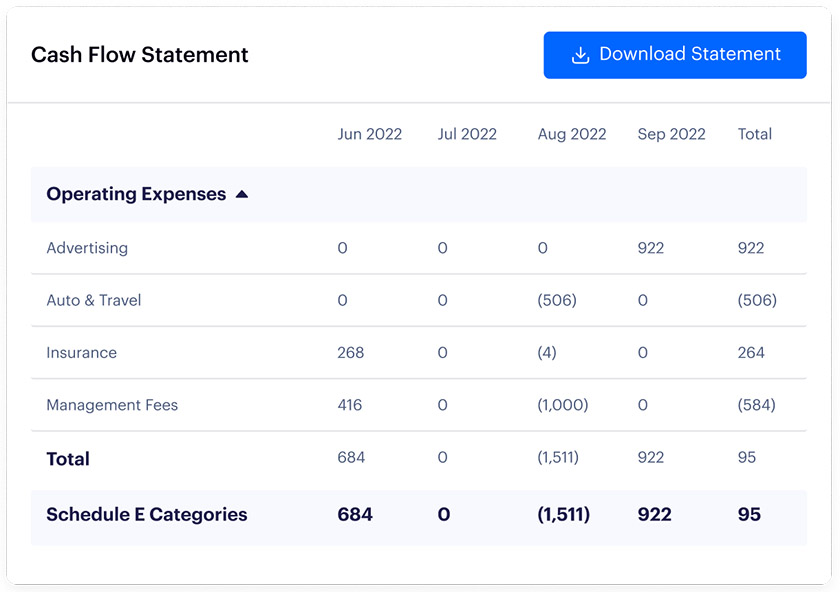
Track your property management and operating expenses through Baselane (Source: Baselane)
Consider using an online property management software like Baselane, which automates income and expense tracking for complete control over your cash flow. This allows you to outsource maintenance while tracking and paying vendors directly through the system. It also keeps expense records, income statements, tax reports, and property insights.
Why Landlords Need to Perform Regular Maintenance
Not keeping your property in its best shape will cost you valuable time, money, and tenants. When your property fails to meet health, safety, and building standards, you may face serious penalties and legal charges from the local and federal government.
Here are some reasons why you should perform regular rental property maintenance:
- To remain compliant with landlord-tenant laws: Landlords are obligated to ensure tenants have safe, habitable spaces by conducting repairs and maintenance, offering waste management, and maintaining common area safety. They must also give prior notice before inspecting the property.
- To protect valuable investments: Neglecting property maintenance can cost more than routine care, impacting your income and return on investment (ROI) when investing in real estate. Damages can lead to tenant complaints, higher turnover, costly repairs, and legal issues.
- To maintain positive tenant relationships: Delayed property repairs can prompt tenants to make their own fixes and deduct expenses from the rental rate. In some states, tenants can sue landlords for housing neglect and break leases without notice. To prevent conflicts and legal disputes, maintain your property diligently.
The Fair Housing Act prohibits the delay or failure to perform rental maintenance and repairs. This means that landlords should address repairs promptly. Though time requirements vary by state, here are some common property maintenance issues and how long a landlord needs to fix them:
- Hot water repair: Within 24 hours
- Air conditioning repairs: 5 to 14 days
- Leaking roof: 30 days
- Refrigerator: 14 to 30 days
- Water system failure: No more than 2 days
- Furnace repair: 3 to 7 days
- Sewage problems: 30 days
Did you know?
The 2024 International Property Maintenance Code (IPMC) provides guidelines for maintaining building elements, ventilation, sanitation, plumbing, mechanical, electrical, and fire protection systems in both residential and non-residential properties. In Section 301, IPMC states that “the owner of the premises shall maintain the structure and exterior property in compliance with these requirements” and that landlords cannot “permit another person to occupy premises that are not in a sanitary and safe condition.”
When to Do Property Inspections for Maintenance
You can perform property inspections multiple times per year as long as they’re not done randomly and don’t interfere with the tenant’s fair use of the property. To guarantee that the property is always at its best, we recommend doing inspections when a client moves in, quarterly or seasonally for routine maintenance, emergencies, and when a tenant moves out.
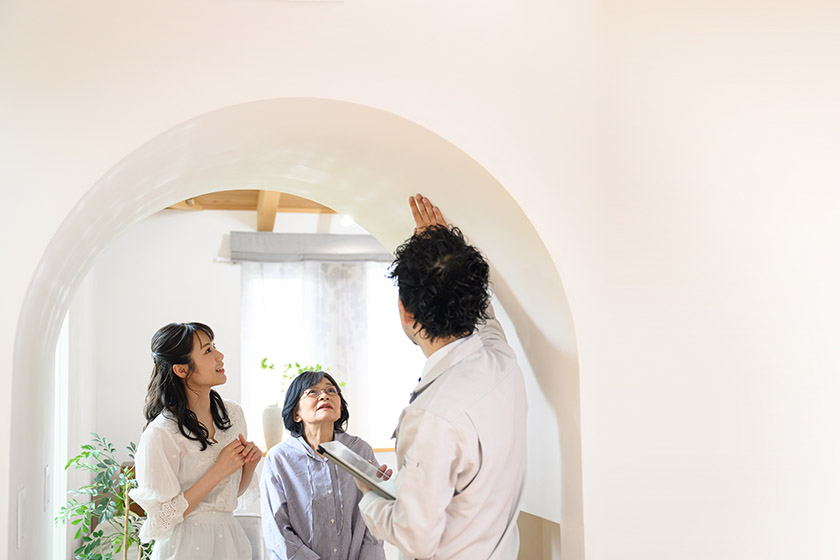
As mentioned, routine and emergency maintenance are essential property upkeep. However, conducting maintenance during tenant move-in and move-out will keep properties in good condition. To ensure a smooth start for new tenants, conduct a move-in inspection to promptly address any normal wear and tear. Additionally, include clear details about property maintenance in the lease agreement to prevent future disputes. For more transparency, document inspection and maintenance using a shared property manager checklist.
Timely inspections are vital in preventing vacancies and lost rental income. Stay organized with a move-in/move-out checklist for systematic inspection. Download our free Move-In/Move-out Checklist below, which you can use with the rental property maintenance checklist.
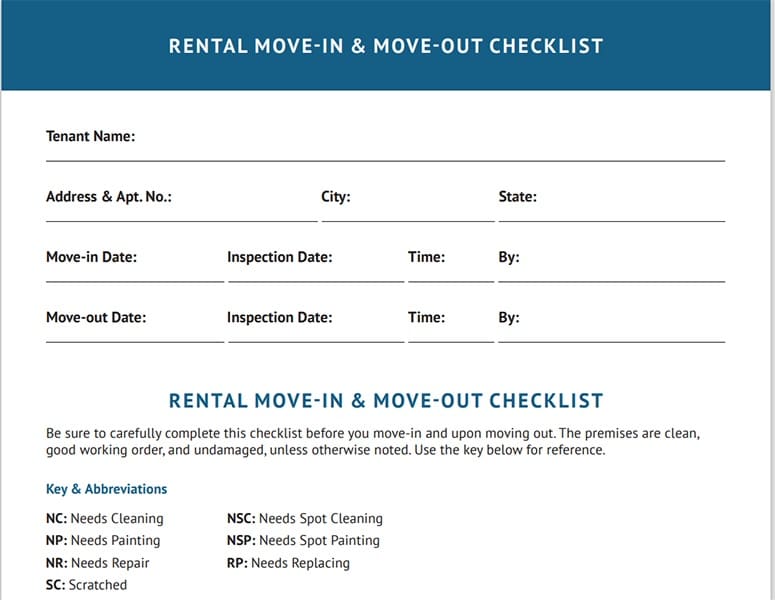
Thank you for downloading!
💡 Quick tip:
Property management software like Avail enables you to be more efficient in maintaining your rentals. Avail is an all-in-one property management solution to help landlords track maintenance and communicate with tenants. Register online in minutes and get started for free.
Calculate the Cost of Property Maintenance
For your rental property to be hazard-free and safe at all times, you must set a realistic maintenance budget. Without this budget, repairs may be delayed, leading to more expenses over time. Estimate repair costs by looking at your receipts and maintenance records from previous years, or use a formula to estimate repairs.
Here are some formulas landlords use to estimate rental property maintenance expenses:
- 1% rule: Maintenance costs about 1% of the property value per year
- 50% rule: Maintenance and repairs are equal to 50% of your total operating costs
- 1.5x rule: Maintenance costs average 1.5x monthly rental income
- Square foot formula: Maintenance will cost about $1 per square foot per year
For example, if you are using the 1% rule on a $250,000 property, your maintenance expenses will be estimated at $2,500 per year. If you are using the square foot formula on a property that is 4,500 square feet, your maintenance costs are estimated to be $4,500 per year.
How to Address Maintenance Requests
If you plan to perform DIY rental property maintenance, identify which tasks to handle by yourself and which will require professional assistance. In general, you should outsource any type of maintenance that requires a license. You may also want to outsource tasks you don’t have time to do. If you live far from your rental property, a property maintenance services list will come in handy in an emergency.
By using property management software, you can easily manage and track maintenance tasks and requests online. Check the table below for the best property management software with robust property maintenance tracking features.
Frequently Asked Questions (FAQs)
A maintenance walk-through is when landlords or property managers inspect a rental property to assess its condition and identify any necessary repairs or maintenance tasks. This walk-through should be conducted regularly, such as before a new tenant moves in or after a tenant moves out, to ensure that the property is well-maintained and up to building code standards. The maintenance walk-through can help landlords and property managers identify potential issues and address them before they become bigger and more costly problems.
Maintenance expenses for a rental property may include repairs and replacements of broken appliances, plumbing and electrical systems, HVAC systems, painting and cleaning, pest control, landscaping, and any other necessary repairs to keep the property in good condition.
A preventive maintenance schedule ensures a property remains in good condition and prevents equipment failure. It outlines the tasks that need to be performed regularly, such as cleaning the gutters, replacing air filters, inspecting the roofing, and servicing the HVAC system, among others, as well as the frequency at which they should be completed. By following the schedule, property owners and managers can keep their properties in good condition, reduce the likelihood of equipment failure, and save money on costly repairs.
Bottom Line
A rental property maintenance checklist guides landlords and property managers in scheduling routine and preventative maintenance tasks and ensuring that their properties are up to building code standards. This property management maintenance checklist puts all of the landlord’s rental property maintenance tasks in one convenient place so they can plan ahead for their weekly, monthly, quarterly/seasonal, annual, and emergency maintenance projects.